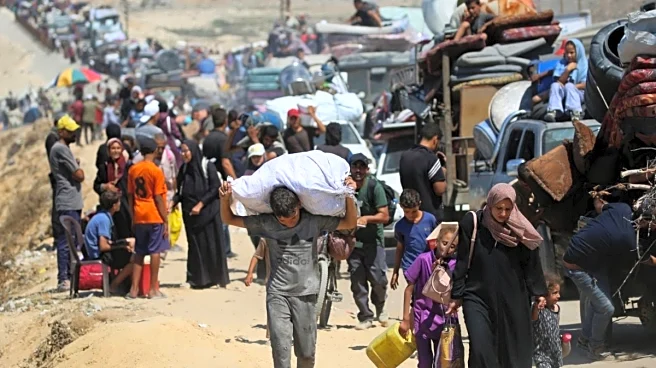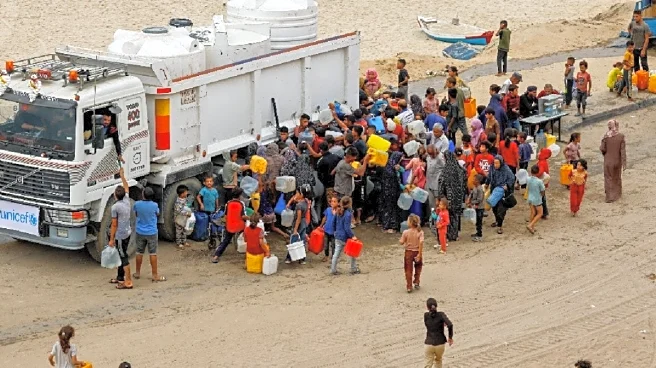The Gaza Strip, once home to over two million people, is today an almost unrecognisable landscape. Satellite images show entire neighbourhoods flattened, while survivors sift through the wreckage for what’s
left of their homes. Following a ceasefire agreement brokered after two years of relentless conflict, attention is shifting to the next monumental phase: rebuilding.
But even as US President Donald Trump declared, “a new and beautiful day is rising and now the rebuilding begins,” global experts warn that reconstruction will be anything but easy. With no clear governance, ongoing security threats, and a bitter scramble for contracts among foreign investors, Gaza’s recovery is poised to become one of the most complex reconstruction efforts of the modern era.
Here’s a full look at what it will take to rebuild Gaza, physically, politically, and economically.
How Much Of Gaza Has Been Destroyed?
The damage is staggering. Estimates suggest that between 60 and 92 per cent of the entire Gaza Strip has been damaged or destroyed. In areas like Gaza City, up to 92 per cent of infrastructure lies in ruins, according to Jaco Cilliers, the UN Development Programme’s (UNDP) special representative for Palestinians.
The UN’s satellite centre UNOSAT estimates that more than 282,000 homes and apartments have been damaged or levelled, a figure likely to be an underestimate, as it does not include destruction from more recent military operations.
The UN Development Programme (UNDP) estimates that around 55 million tonnes of rubble now blanket Gaza. Separately, the BBC, using satellite imagery, suggests the figure could exceed 60 million tonnes. To visualise the scale, Jaco Cilliers, UNDP’s special representative for Palestinians, said the debris could stack 12 metres high across New York’s Central Park, or be enough to build 13 pyramids the size of Giza’s Great Pyramid. Entire districts have been erased, including roads, public buildings, and basic utilities.
Gaza’s housing stock alone could take decades to rebuild, especially if the effort is hampered by the kind of Israeli restrictions on construction materials, such as cement and steel, that slowed rebuilding after the 2014 and 2021 wars, according to Shelly Culbertson, a senior policy researcher at the Washington-based think tank, RAND Corporation. “If you rebuild now the way they did in 2014 and 2021, it will take 80 years. If there’s good planning, it could take less time,” she said to the BBC.
What Are The Most Urgent Needs Right Now?
Even before long-term rebuilding begins, Gaza faces an immediate humanitarian emergency. Over 500,000 displaced Palestinians have returned to the Strip in recent days, many of them to find their homes completely destroyed. Over 90 per cent of housing is either damaged or uninhabitable, especially in northern Gaza and Gaza City.
Winter has set in, but large numbers of Gazans continue to live in tents or makeshift shelters, often without access to clean water, food, or sanitation. Conditions remain catastrophic, with cholera, tuberculosis, and diarrhoeal diseases posing a serious threat due to the collapse of essential infrastructure.
The first priority is clearing the rubble, not just to allow reconstruction, but to prevent further loss of life. Experts warn the debris is littered with unexploded ordnance, decomposing human remains, and toxic residue from munitions, which could pose grave health and safety risks to returning civilians and workers.
According to UNICEF, over 70 per cent of Gaza’s 600 water and sanitation facilities have been damaged or destroyed since October 2023. Six major wastewater treatment plants, including the Sheikh Ejleen facility in Gaza City, are no longer operational. Satellite imagery reviewed by the BBC confirms extensive damage to these plants, some of which were set ablaze or re-attacked after initial repairs.
In parallel, the collapse of agriculture, with over 80 per cent of crops and 97 per cent of orchards damaged, has triggered famine-like conditions in parts of Gaza, particularly Gaza City.
How Much Will It Cost To Rebuild Gaza?
The latest joint estimate by the UN, EU, and World Bank places the cost of rebuilding Gaza at $70 billion, a sharp rise from the $53 billion estimated just months earlier in February. Of that, at least $20 billion will be required in the next three years alone to meet basic rebuilding benchmarks. These include housing, schools, electricity, roads, sanitation and essential public services.
Funding remains a massive hurdle. With no clear roadmap on who will administer Gaza in the long run, and no consensus over how to manage donor funds, the money is yet to materialise. While US President Trump has proposed an international investment-led plan, Trump Economic Development Plan, critics say it lacks transparency, accountability, and local buy-in.
What Is Trump’s Economic Plan?
Speaking at the peace summit in Sharm El-Sheikh, Trump declared that “rebuilding is maybe going to be the easiest part,” and promised that the US and its allies would help build “better than anyone in the world.” His plan envisions an international panel of experts directing private capital into rebuilding efforts, from roads and water systems to hospitals and new commercial hubs.
A centrepiece of the plan is the proposed creation of a Special Economic Zone (SEZ) inside Gaza, which would offer tax-free, tariff-free incentives to foreign investors. But human rights organisations have sounded the alarm. The Business and Human Rights Resource Centre warns that the SEZ could become an enclave economy benefiting foreign firms with low-paid, unregulated jobs, while depriving Palestinians of control, tax revenue, and labour protections.
Even more troubling is the involvement of companies previously accused of profiting from the Israeli occupation. A recent UN database listed 158 firms, from arms manufacturers to surveillance giants, linked to the occupation economy. Many of these same companies are now reportedly eyeing contracts under the Trump plan.
Who Will Lead The Rebuilding?
That question remains unresolved. Rebuilding efforts in conflict zones typically require some form of political transition or interim administration. But Hamas has not disarmed, and Israel still occupies parts of Gaza, making the governance vacuum a central obstacle.
Former US ambassador to Israel Jack Lew, speaking to NPR, said the success of reconstruction will depend on creating a security force to stabilise neighbourhoods, disarm militias, and pave the way for Palestinian-led governance. International troops, including those under CENTCOM, are expected to provide logistical support, but long-term control must shift to trained local authorities.
Without disarmament, no aid agency or private contractor can operate safely. And without a legitimate local authority, any reconstruction risks being seen as imposed, illegitimate, or exploitative.
Can Gaza Recover Without Its People Leading The Effort?
Not likely. Rights groups stress that any reconstruction plan that excludes Palestinian consultation, regulation, and oversight will fail in human terms. Gaza needs jobs, but not ones that trap workers in unsafe or exploitative conditions. It needs investment, but not at the cost of sovereignty or dignity.
The Road Ahead
Clearing the rubble of Gaza will take years. Rebuilding homes, hospitals, power grids and sewers may take decades. But without a credible political settlement, disarmament roadmap, and reconstruction plan, these efforts may remain suspended in uncertainty.
For now, one phase of Gaza’s suffering has ended. What comes next may shape the region’s future.


/images/ppid_59c68470-image-17603450654997254.webp)


/images/ppid_59c68470-image-17603425318199982.webp)
/images/ppid_59c68470-image-176034753174640270.webp)

/images/ppid_59c68470-image-176035003906050086.webp)


/images/ppid_59c68470-image-176035509951175141.webp)
/images/ppid_59c68470-image-176034004081924741.webp)